You must be logged in to rate content!
14 minute read
Adjustable Control Arm / LCA / Lower Control Arm FAQ
Compliments of JMortensen @ http://forums.hybridz.org
8-2-2007
We have a few options for adjustable control arms for Z cars. We can purchase parts from any number of vendors or we can make the parts adjustable at home with a welder, some patience, and some skill. This thread will look at the differences between different designs and compare and contrast features. It will also compare the adjustable arm to other adjustable parts like camber plates and bushings. Let's start with a little safety info about what is probably the most controversial part of the various designs available... the rod end.
ROD END SAFETY--
Most of these parts use rod ends to adjust the length of the arm. Rod ends are spherical bearings with a threaded end (male or female). Rod ends should never be set so that the amount of thread engaged is less than 1.5x the diameter of the end itself. So a 5/8" rod end would need 15/16" threads engaged in order to be considered properly installed. A typical 5/8" rod end has 1 5/8" of threaded shank, so that means that you have 11/16 available thread to adjust with. Subtract the thickness of the jam nut which is 3/8", and that leaves you with not a whole lot of adjustment--5/16" to be exact.
http://www.aurorabea...qs/default.html
THREADS IN BENDING--
I'm not an engineer, but I'll do my best to describe this issue. A stress riser is a sharp edge, and a sharp edge on any stressed part can lead to a crack. The threads in the rod ends used in most of the control arm designs are stress risers. The worst thing you can do to a stress riser is put it under a bending load. Particularly in the rear of the Z, this is exactly what we are doing. The farther the rod end is extended, the wose the bending load is. The bending load tries to spread open the threads and "continue" the crack. If the crack does propogate, this is going to result in a snapped rod end, which results in sudden and violent toe change which most likely will end with the other rod end letting go, and from there an accident. You need to decide whether that risk is acceptable and what kind of maintenance and inspection schedule is appropriate for these parts.
NVH--Since rod ends have no insulating property, the vibrations in the control arms will be transferred to the chassis. This makes the cabin more noisy, but there is a more serious factor at work. The lack of a bushing means that sudden impacts to the suspension will also be transferred to the chassis and these can lead to weakening of the structure of the car, weakening of the control arm, or both.
ON THE CAR ADJUSTABLE--
On the car adjustable simply means that you do not have to disconnect parts of the suspension in order to adjust the length of the arm. This feature is a selling point of many of the available control arms, and is particularly important in the rear control arms.
A NOTE ON FRONT CAMBER BUSHINGS--
Camber bushings are available for our Z cars as an alternative to adjustable control arms, and these have limitations that are often overlooked. When one adjusts the camber the toe changes as well. The bumpsteer also changes. The bushings don't adjust camber very much (about 1 degree total adjustment) and they necessarily bind the front suspension. As the front control arm moves up and down, the TC rod pivots with it. The TC rod pivots on an arc, and this arc wants to make the control arm forward until the TC rod is parallel to the ground, then back until the suspension bottoms. The camber bushings don't allow for this swing since they are made from very hard Delin and aluminum, so this stress is taken up jointly by the TC bushings and the crossmember. Stock rubber bushings will flex to allow this sweep, although commonly used polyurethane is also fairly stiff and increases the stress on these parts. A rod end on an adjustable control arm allows for this movement with no increased stress at the crossmember or the TC rod. The suspension is free to travel its natural arc without any binding or increased friction.
ADJUSTABLE FRONT CONTROL ARMS--
Adjustable front control arms can be used to adjust the front track or to adjust front camber. Whenever an adjustment is made to the front control arms it will change the toe setting, so toe will always need to be adjusted after adjusting a front control arm's length. This situation makes adjustable front control arms less desireable for at-the-track camber changes, even when the arms are on the car adjustable. What is more desirable from a quick adjustment perspective is a camber plate. Camber plates, especially the slotted type, can be adjusted for street driving and then changed at an autox or a track day and again changed back in a matter of minutes for the drive home. Changing camber at the plate does not affect the toe setting, making it a much more convenient way to go. What adjustable front control arms can do is change the track width or possibly even square up a car that has been in a wreck. They can also make small camber changes with the rod ends, but the custom arms can be made longer to add larger amounts of negative camber if desired.
Here is an on the car adjustable front LCA from gijonas: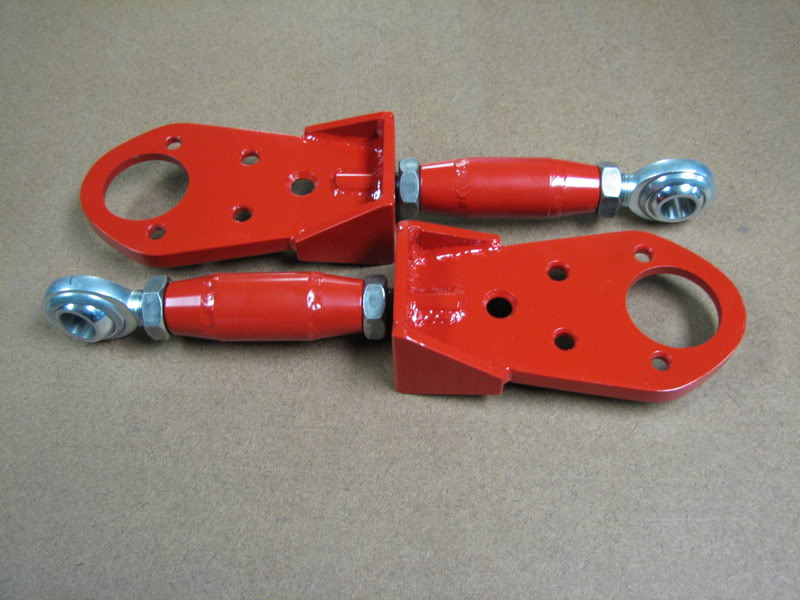
And here it is installed:
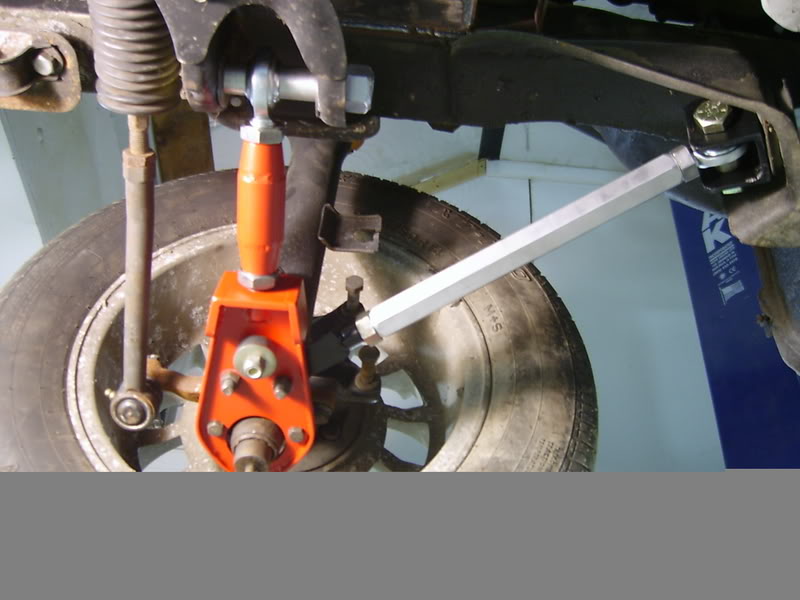
For the purpose of changing track or squaring up a car, or adding longer arms to make large camber adjustments, adjustable arms which are not on the car adjustable can be used to good effect. They can be adjusted by removing the inner control arm pivot and unscrewing the rod end or by disconnecting the sway bar and ball joint and unscrewing the outboard end of the control arm.
Here is a sequence of pictures of bjhines's custom fabricated front control arms (not on the car adjustable). This is just one way to do this job. Another is to weld a tube into the control arm and then weld a threaded tube end that fits a male rod end into the end of the tube.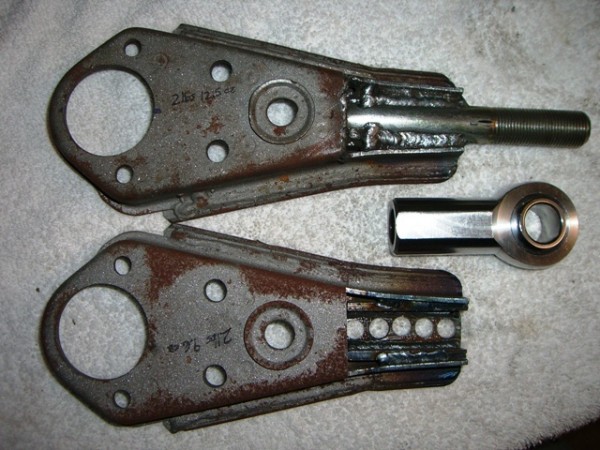
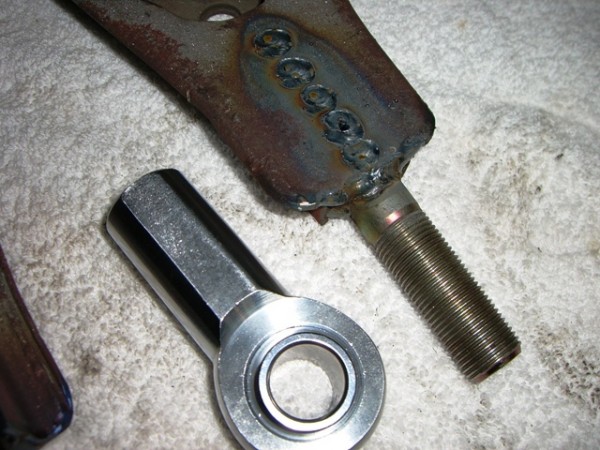
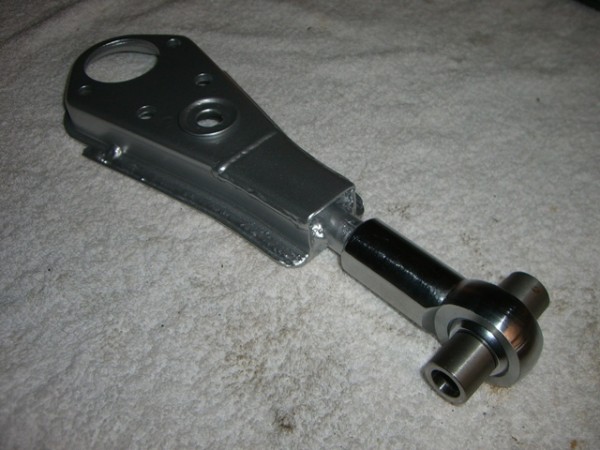
Another issue to keep in mind is that the tie rod has to be lengthened to match the control arm. The tie rod has a limited amount of adjustment and it is very easy to lengthen a control arm past the point of safety on the tie rod. This is very important to note, as there are no commercially available aftermarket tie rod ends for Z cars as far as I know, but quite a few adjustable front control arms. It is possible to make your own custom length tie rods, but it requires some modification to the steer knuckle or some machining to complete that job. Here is a thread on that subject, below are a few pictures of various custom tie rod ends: http://forums.hybrid...ad.php?t=111435
jmortensen's tie rods:
bjhines's tie rods:
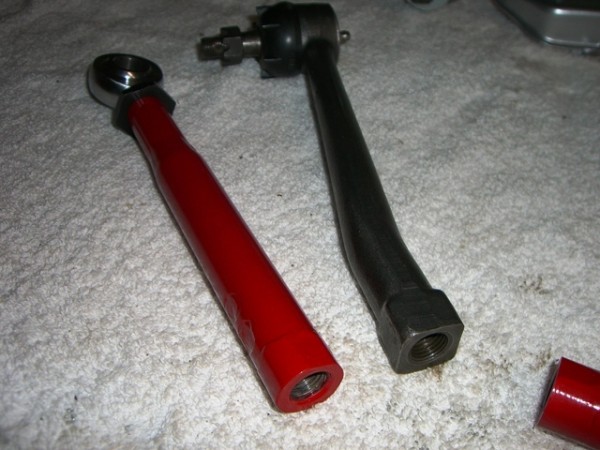
ADJUSTABLE REAR CONTROL ARMS--
The Z rear control arms are not adjustable and there is no stock provision for toe or camber adjustment. The most common and easy method for adjusting camber and toe in the back of a Z is by using offset bushings like those available through G Machine. These are a cheap and easy alternative to changing control arms and work reasonably well in the rear.
If you need more adjustment or are interested in the idea of adjustable arms for reducing friction or deflection, then adjustable rear arms may be a solution for you.
On the car adjustment takes on a whole new importance on the rear control arm. The difference between the front rod end and rear rod end is going to determine the toe setting for the rear tire. This difference gets multiplied as the changes are made ~6" away from each other at the rod end but they affect a wheel that might be 25" in diameter. So a small difference at the rod end makes a much larger difference at the tire. With this being the case, on the car toe adjustment becomes much more important. The arms that do not have on the car adjustment require that the spindle pin be pulled to adjust the toe, then the rod end turned out or in by 1/2 turn increments, then the spindle pin be reinserted and the jam nuts locked down. This results in a very coarse adjustment for toe, and it is probable that the resulting toe setting would not be identical on both sides. On the car adjustment in this case means that the rod ends don't have to be turned in order to adjust the toe, which means that the toe can be changed to an infinite number of settings and can be dialed in to the exact setting preferred.
Again, adjusting the camber with the control arm in the rear is not a very convenient way to go. If one is using the on the car adjustable arms, the adjusters have to be turned out exactly the same amount front and rear in order to prevent a toe change. If one is not using an on the car adjustable arm, then the rod ends can be turned out x number of turns front and back, but in order to make an adjustment the spindle pin has to be removed to make the adjustment. In addition, some rear control arms have either the front or rear rod end on the car adjustable for toe, but not the other one. In that case the spindle pin would need to be pulled to make and adjustment AND the toe would need to be reset afterwards. Camber plates are a much better way of adjusting camber than adjustable rear control arms. Even the offset bushings, which can be a pain to adjust, are much easier to deal with.
Here is a picture of bjhines's custom fabricated rear control arm which is not on the car adjustable:
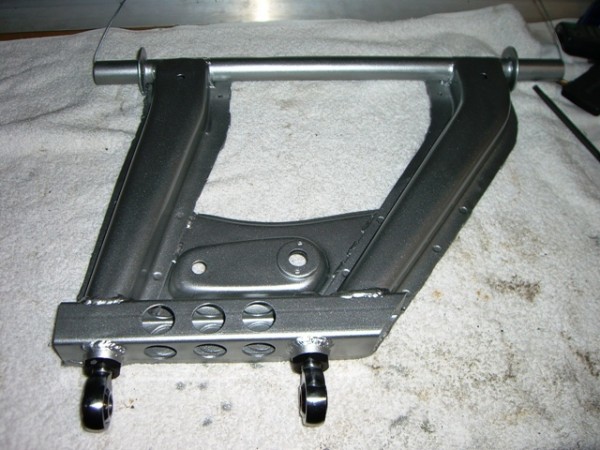
If the primary reason for using adjustable control arms is to reduce friction and deflection, then the ease of adjustment for toe and camber can be ignored. In my own case this is true, and what I have done is to use a camber plate to adjust camber, I can make track changes by adjusting the rod ends a bit, and I have another on the car toe adjuster which is not part of the control arm itself and does nothing but adjust toe. This piece spreads the rear inner bushings of the rear control arm by lengthening the transverse link which sits behind the differential. This piece was developed in this thread and different people varied their implementation of the same design idea a little bit: http://forums.hybrid...ead.php?t=89111
jmortensen's:
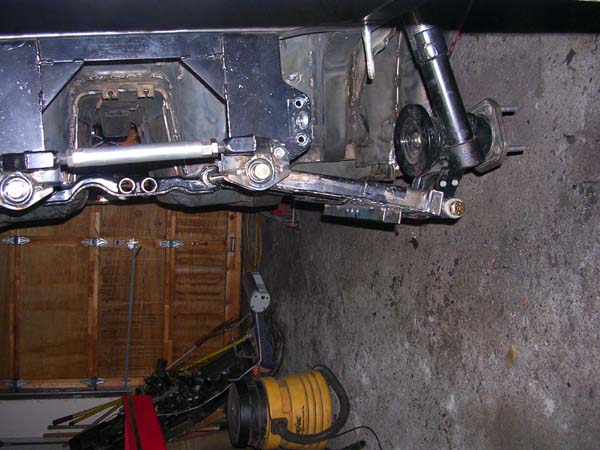
blueovalz's:
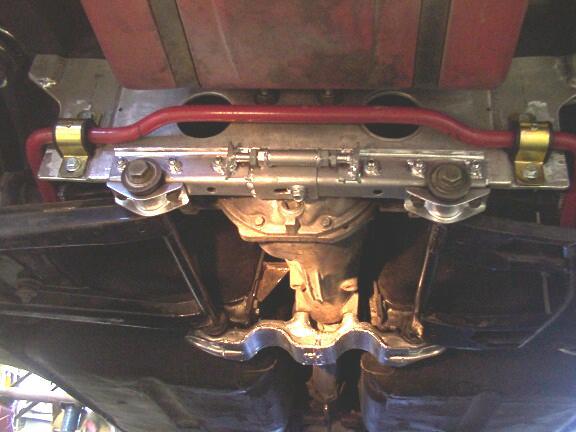
Most adjustable control arms still use polyurethane or nylon bushings for the inner connections. There is a way to further reduce friction, and that is to use a monoball to replace the inner bushings. I had rolled this idea around in my head for more than a decade before I finally got this done, primarily with the help of Terry Oxandale and Cary McAllister. Here is the thread on this modification, and again, various implementations of the idea (Terry's bolt in version is particularly nice): http://forums.hybrid...ad.php?t=106457
Terry's excellent bolt in monoball inner pivot: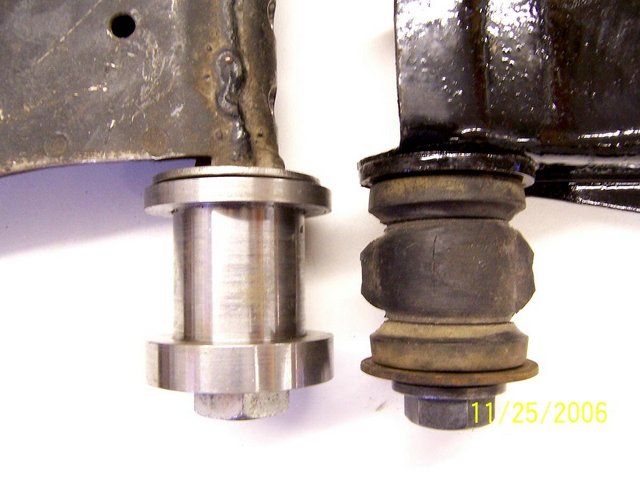
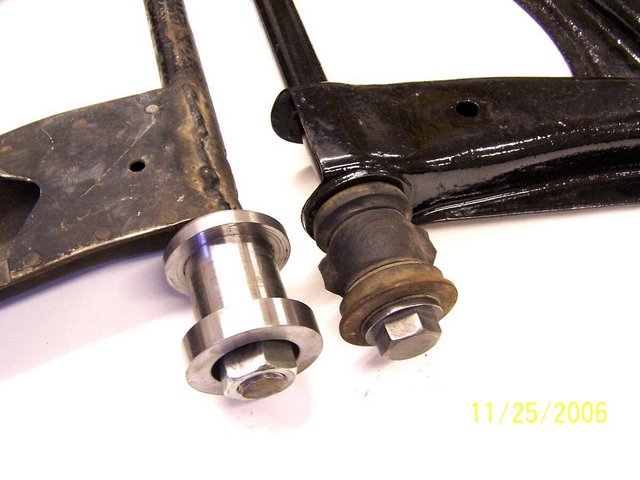
jmortensen's weld in monoball inner pivots:
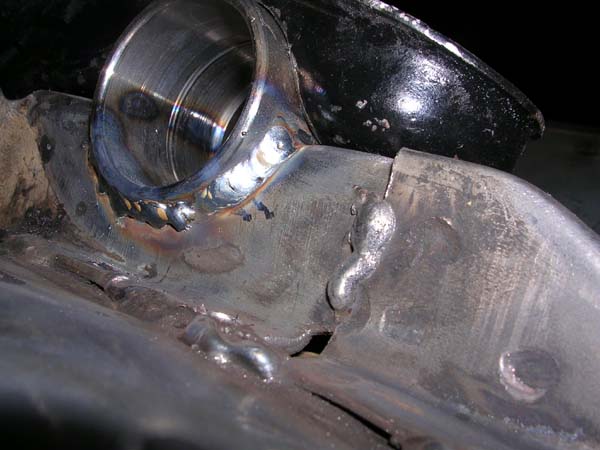
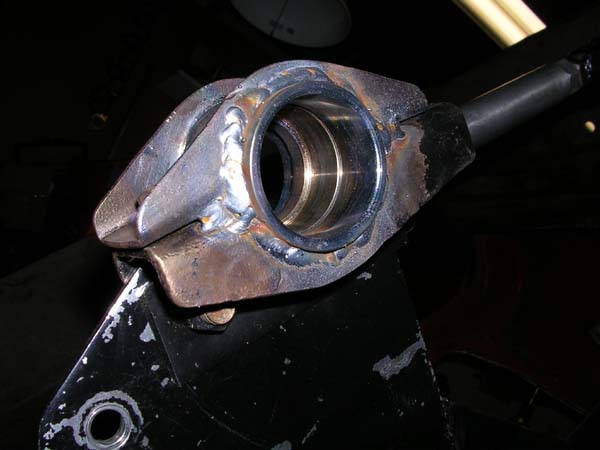
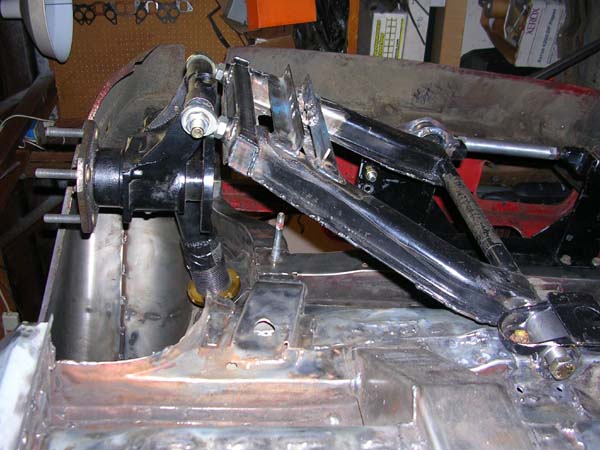
SUMMARY--
Whether you buy it or make it there are several reasons for using adjustable control arms. Camber change is possible with these arms, but not easy, and is limited by the length of the tie rods in the front and the amount of thread engagement of the rod ends in the front and the rear. Toe adjustment is irrelevant in the front and requires a well designed adjuster with on the car adjustability in the rear. Track width adjustment is possible with both front or rear adjustable arms, but is again limited by the rod end thread engagement. Track can be changed for either squaring a bent chassis or just adjusting to make the car handle better (wider track = better grip on that end of the car). Reduction of friction is a key to good handling, and using rod ends or monoballs will dramatically reduce friction when compared to polyurethane bushings. Reduction of deflection keeps the alignment settings more consistent, and also keeps the suspension from binding. All of these factors allow the suspension to be more compliant, allowing the suspension to keep the tire on the road even with stiffer spring rates and shock valving.
Adjustable control arms are not necessary for your street Z car. Most of them are also not all that adjustable when it really comes down to it. But there are some good reasons for using them and various different ways of implementing the common design ideas. Every modification of the suspension is going to require a fairly deep knowledge of the potential problems associated with it, and there are some pretty serious pitfalls that can catch you offguard if you're not aware. Do as much research as possible on the design strengths and weaknesses of any parts you might purchase. Don't weld your own suspension parts if you're not experienced and don't trust your fabrication skills. Similarly there are more and more small companies and ebay sellers offering these parts out there and none of them are very big. The level of engineering and failure testing of any of these parts is usually (always???) completely unknown. We have had people design a part and make a prototype, post pictures of it here, get feedback and use the feedback on the forum to redesign the part. Sounds good so far... but then, presumably with no failure analysis testing, it was put up for sale on ebay. Is the part "safe"? It's impossible to say. It truly is a "caviat emptor" world out there. Any of the above modifications are done at your own risk.

